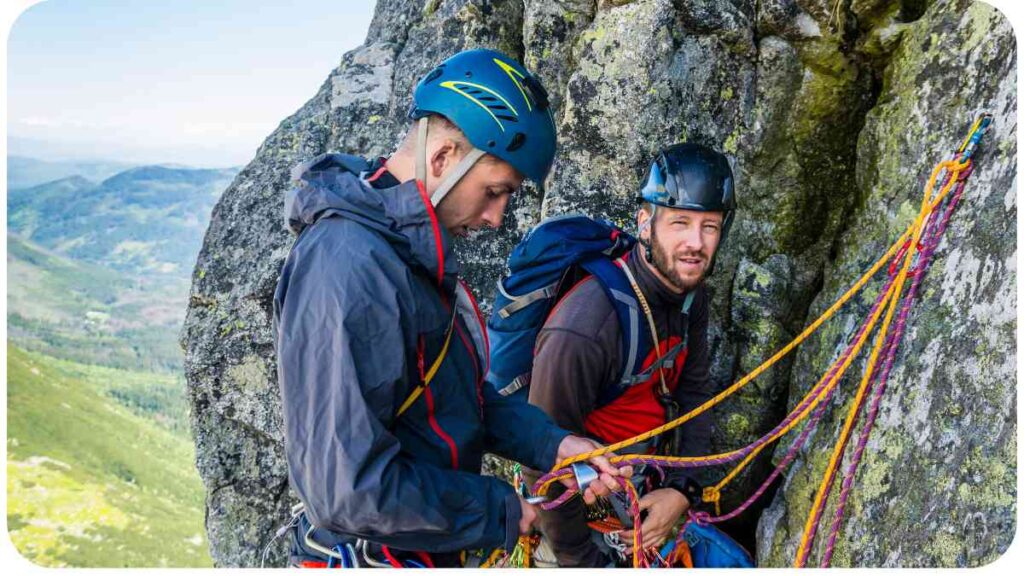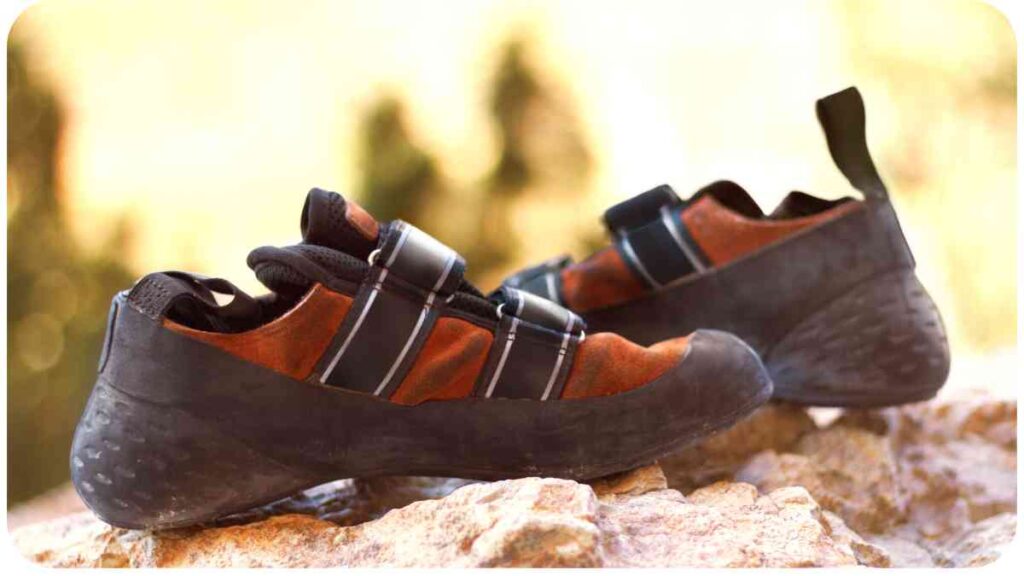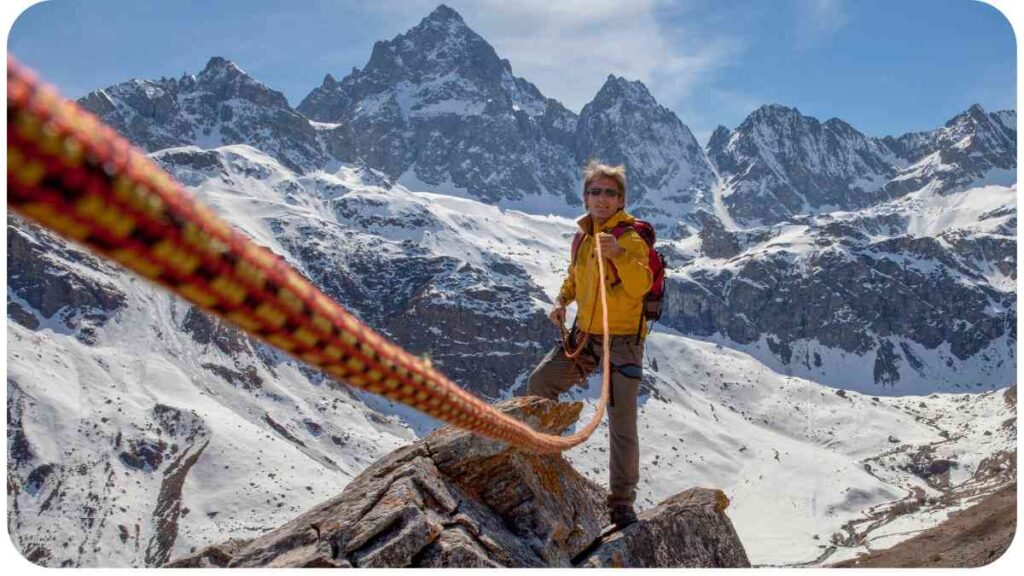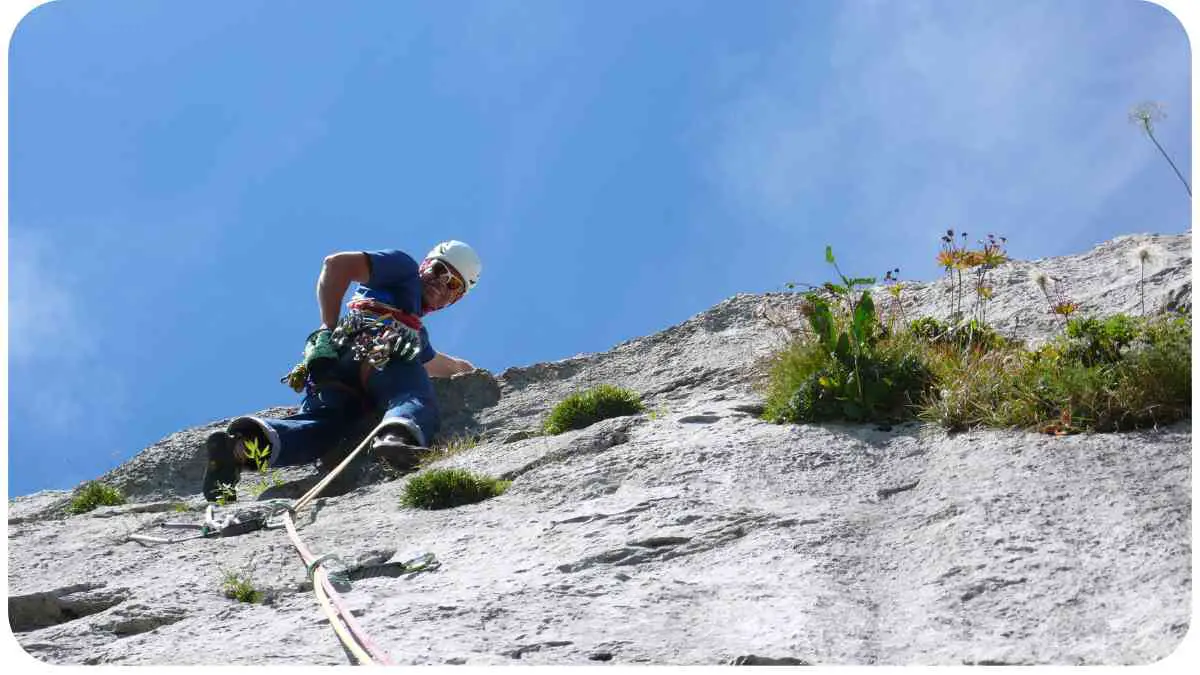Lead climbing is an exhilarating form of rock climbing where the climber ascends a route, attaching themselves to protection points as they progress.
Unlike top-rope climbing, where the rope is pre-hung, lead climbing involves the climber carrying the rope, clipping it into safety points, and dealing with potential falls.
| Takeaways |
| Mastering lead climbing involves a combination of proper gear, essential techniques, and mental resilience. |
| Choosing the right climbing routes based on grading, progression levels, and personal preferences is crucial for success. |
| Building strength and endurance through targeted exercises and a consistent training schedule is essential for lead climbing improvement. |
| Safety measures, effective communication, and emergency procedures are fundamental for a secure lead climbing experience. |
| Seeking mentorship, joining climbing communities, and learning from success stories contribute to a well-rounded climbing journey. |
Table 1: Key Terms
| Term | Definition |
| Lead Climbing | Climbing where the climber carries the climbing rope. |
| Protection Points | Secure points for attaching the climbing rope. |
| Top-Rope Climbing | Climbing with a pre-hung rope for added safety. |
Mastering lead climbing opens up new challenges and rewards, pushing climbers to develop advanced skills. The increased responsibility and mental fortitude required make it a significant milestone for those seeking personal growth in their climbing journey.
If you’re new to ice climbing, explore the beauty and thrill of the sport at the Best Ice Climbing Spots for Beginners. Discover accessible yet breathtaking locations to kickstart your ice climbing journey.
Table 2: Benefits of Lead Climbing
| Benefit | Description |
| Skill Development | Improves climbing techniques and mental resilience. |
| Expanded Climbing Opportunities | Access to routes not suitable for top-rope climbing. |
| Confidence Building | Overcoming fears and gaining confidence in your abilities. |
2. Essential Gear for Lead Climbing

2.1 Harness and Helmet
The foundation of lead climbing gear begins with a reliable harness and helmet. The harness provides a secure attachment point for the rope, while the helmet protects against potential head injuries from falling debris.
Embark on your ice climbing adventure with confidence using our comprehensive Beginner’s Guide to Ice Climbing in the USA. From essential gear to basic techniques, this guide ensures you’re well-prepared for the icy challenge.
Table 3: Recommended Gear Brands
| Gear | Recommended Brands |
| Harness | Black Diamond, Petzl, Arc’teryx |
| Helmet | Mammut, Edelrid, Camp |
2.2 Dynamic Ropes
Dynamic ropes are designed to stretch, absorbing the energy of a fall. Choosing the right rope is crucial for safety and performance.
Table 4: Rope Specifications
| Rope Diameter | Recommended Use |
| 9.8mm | Versatile for various conditions |
| 9.2mm | Lightweight for advanced climbers |
| 10.5mm | Durable for frequent use |
2.3 Quickdraws
Quickdraws connect the rope to protection points on the climbing route. Having a variety of lengths ensures flexibility in different climbing scenarios.
Brace yourself for an adrenaline-pumping experience at the Most Thrilling Ice Climbing Spots in the USA. Conquer nature’s wonders and test your skills on these exhilarating and breathtaking ice climbing routes.
Table 5: Quickdraw Lengths and Brands
| Quickdraw Length | Recommended Brands |
| 12cm | Black Diamond, Petzl, Wild Country |
| 18cm | Mammut, DMM, Metolius |
| 25cm | Edelrid, CAMP, Grivel |
2.4 Climbing Shoes

Specialized climbing shoes provide the necessary grip and support for challenging climbs.
Table 6: Climbing Shoe Types
| Shoe Type | Recommended Brands |
| Neutral | La Sportiva, Scarpa, Five Ten |
| Aggressive | Evolv, Tenaya, Mad Rock |
2.5 Belay Device
A reliable belay device is crucial for controlled descent and safety during lead climbing.
Table 7: Belay Device Options
| Belay Device Type | Recommended Brands |
| Assisted Braking | Petzl GriGri, Black Diamond ATC Pilot |
| Tube Style | Black Diamond ATC, Edelrid Mega Jul |
Having the right gear sets the stage for a successful lead climbing experience.
3. Understanding Lead Climbing Techniques
3.1 Clipping Techniques
Proper clipping is essential for safety and efficiency in lead climbing. Use quickdraws strategically, and practice smooth and swift clipping motions.
Table 8: Clipping Tips
| Tip | Description |
| Anticipate Holds | Plan your clips before reaching a difficult section. |
| Consistent Technique | Develop a routine for clipping to reduce errors. |
| Practice Mock Leads | Simulate lead climbs to refine your clipping skills. |
3.2 Body Positioning
Effective body positioning enhances your climbing ability. Keep your body close to the wall and maintain a balanced stance.
Table 9: Body Positioning Tips
| Tip | Description |
| Core Engagement | Strengthen your core for better body control. |
| Weight Distribution | Distribute your weight over your feet for balance. |
| Efficient Resting | Learn to rest efficiently on holds when needed. |
3.3 Route Reading
Being able to read a climbing route is a crucial skill. Look for key features and plan your moves accordingly.
Elevate your ice climbing prowess with the insights found in The Ultimate Guide to Ice Climbing in the USA. Gain valuable tips, techniques, and discover must-visit spots that define the essence of this challenging and rewarding sport.
Table 10: Route Reading Tips
| Tip | Description |
| Identify Crux Points | Recognize the most challenging parts of the route. |
| Hand and Foot Matching | Coordinate hand and foot movements for efficiency. |
| Visualize Sequences | Picture the sequence of moves before executing. |
3.4 Fall Dynamics
Understanding how to fall safely is as important as climbing itself. Practice falling techniques in a controlled environment.
Table 11: Fall Dynamics Tips
| Tip | Description |
| Controlled Breathing | Stay calm and regulate your breathing during a fall. |
| Bent Knees and Roll | Land with slightly bent knees and roll upon impact. |
| Trust in Gear | Have confidence in your equipment’s fall-catching ability. |
Now that we’ve covered essential lead climbing techniques, let’s move on to developing the
4. Developing Strength and Endurance
4.1 Specific Exercises
Building strength and endurance is crucial for tackling challenging lead climbs. Incorporate targeted exercises into your training routine.
Table 12: Strength and Endurance Exercises
| Exercise | Targeted Muscles |
| Hangboard Training | Finger and grip strength |
| Campus Board Exercises | Upper body and core muscles |
| Endurance Climbing Sets | Full-body endurance development |
4.2 Training Schedule
Establishing a consistent training schedule is key to progress. Mix in lead climbing sessions with targeted strength training.
Dare to face the extreme with a journey through the Most Dangerous Ice Climbing Routes in America. This guide navigates you through perilous yet awe-inspiring routes, challenging your courage and skills in the world of ice climbing.
Table 13: Weekly Training Schedule
| Day | Activity |
| Monday | Strength training |
| Tuesday | Bouldering or lead climbing |
| Wednesday | Rest day |
| Thursday | Endurance climbing |
| Friday | Rest or light cardio |
| Saturday | Outdoor climbing or rest |
| Sunday | Long lead climbing sessions |
4.3 Rest and Recovery
Allowing your body to recover is as important as training itself. Incorporate rest days into your schedule and prioritize quality sleep.
Table 14: Recovery Tips
| Tip | Description |
| Active Recovery | Light activities like stretching or yoga. |
| Hydration and Nutrition | Proper fueling for recovery and muscle repair. |
| Adequate Sleep | Ensure 7-9 hours of quality sleep per night. |
Balancing training and recovery sets the stage for long-term success in lead climbing.
5. Mental Aspects of Lead Climbing
5.1 Overcoming Fear
Facing fear is inherent in lead climbing. Acknowledge your fears, gradually expose yourself to challenging situations, and celebrate each small victory.
Table 15: Fear Overcoming Strategies
| Strategy | Description |
| Visualization | Imagine successful climbs to boost confidence. |
| Positive Self-Talk | Replace negative thoughts with positive affirmations. |
| Gradual Exposure | Gradually increase the difficulty of your climbs. |
5.2 Focus and Concentration
Maintaining focus is crucial for success in lead climbing. Train your mind to stay present and focused on the task at hand.
Table 16: Focus and Concentration Tips
| Tip | Description |
| Mindful Breathing | Use controlled breathing to stay centered. |
| Goal Setting | Set achievable goals for each climbing session. |
| Eliminate Distractions | Create a focused climbing environment. |
5.3 Problem-Solving on the Wall
Lead climbing often requires quick thinking and adaptability. Develop problem-solving skills to navigate unexpected challenges.
Table 17: Problem-Solving Strategies
| Strategy | Description |
| Assessing Holds | Quickly assess and adapt to the available holds. |
| Route Adjustment | Modify your approach based on changing conditions. |
| Analyzing Climbing Errors | Learn from mistakes and adjust your strategy. |
6. Choosing the Right Climbing Routes
6.1 Route Grading
Understanding route grading is essential for selecting climbs that match your skill level. Familiarize yourself with the grading system used in your climbing area.
Table 18: Climbing Route Grades
| Grade | Difficulty Level |
| 5.8 – 5.10 | Beginner to Intermediate |
| 5.11 – 5.12 | Intermediate to Advanced |
| 5.13 and above | Advanced to Expert |
6.2 Progression Levels
Gradually progress through climbing grades to build skills and confidence. Consistent improvement is key to mastering lead climbing.
Table 19: Progression Milestones
| Level | Description |
| Beginner | Comfortable with 5.8 – 5.9 routes |
| Intermediate | Successfully climbing 5.10 – 5.11 routes |
| Advanced | Consistently tackling 5.12 – 5.13 routes |
| Expert | Mastery of 5.13 and above climbs |
6.3 Tips for Route Selection
Consider factors beyond grading when choosing climbing routes. Assess the type of holds, the style of climbing, and potential crux sections.
Table 20: Route Selection Tips
| Tip | Description |
| Hold Types | Familiarize yourself with different types of holds. |
| Crux Identification | Identify and strategize for the most challenging sections. |
| Style Preferences | Choose routes that align with your preferred climbing style. |
Understanding route characteristics enhances your ability to select climbs that align with your climbing goals.
7. Safety Measures and Risk Management
7.1 Partner Communication
Clear communication with your climbing partner is crucial for a safe lead climbing experience. Establish a set of signals and check-ins.
Table 21: Communication Protocols
| Signal | Meaning |
| Three Tugs | Belay is ready. |
| Two Taps | Climber is ready to climb. |
| Continuous Tugging | Emergency – stop climbing immediately. |
7.2 Checking Gear
Regularly inspecting your gear is a fundamental safety practice. Conduct pre-climb checks to ensure all equipment is in optimal condition.
Table 22: Pre-Climb Gear Inspection
| Gear | Inspection Points |
| Harness | Check for wear, tears, or loose straps. |
| Helmet | Inspect for cracks, dents, or any damage. |
| Ropes | Examine for frays, cuts, or abrasions. |
| Carabiners | Ensure gates open and close smoothly. |
| Belay Device | Verify proper functionality and condition. |
7.3 Emergency Procedures
Knowing how to respond in emergencies is vital. Establish and rehearse emergency procedures with your climbing partner.
Table 23: Emergency Response Plan
| Emergency | Action |
| Fall | Remain calm, assess injuries, call for help. |
| Gear Malfunction | Use an emergency knot to secure the climber. |
| Communication Loss | Establish backup signals or visual cues. |
8. Common Lead Climbing Mistakes to Avoid

8.1 Lack of Communication
Communication breakdowns can lead to accidents. Establish a clear communication protocol with your partner and consistently use it.
Table 24: Communication Best Practices
| Best Practice | Description |
| Regular Check-Ins | Confirm signals and understanding throughout the climb. |
| Emergency Signal Drills | Practice emergency signals regularly for quick response. |
| Post-Climb Debrief | Discuss the climb afterward to address any issues. |
8.2 Poor Route Planning
Inadequate route planning can lead to challenges beyond your skill level. Thoroughly research and plan your climbs in advance.
Table 25: Route Planning Tips
| Tip | Description |
| Research Climbing Area | Understand the grading system and route characteristics. |
| Weather Check | Consider weather conditions and their impact on the climb. |
| Know Your Limits | Choose routes that challenge but do not exceed your abilities. |
8.3 Inadequate Gear Inspection
Neglecting gear inspections increases the risk of equipment failure. Regularly check and maintain your climbing gear.
Table 26: Gear Inspection Schedule
| Frequency | Inspection Points |
| Before Each Climb | Quick check for visible damage or issues. |
| Monthly | Thorough inspection of all gear components. |
| Annually | Professional evaluation of harness and ropes. |
8.4 Ignoring Mental Preparedness
Underestimating the mental aspects of lead climbing can lead to poor decision-making. Prioritize mental preparation and mindfulness.
Table 27: Mental Preparedness Strategies
| Strategy | Description |
| Visualization | Picture successful climbs in your mind. |
| Relaxation Techniques | Learn techniques to calm nerves and reduce anxiety. |
| Positive Affirmations | Develop a positive mindset for challenging climbs. |
9. Advancing Your Lead Climbing Skills
9.1 Advanced Techniques
As you progress in lead climbing, consider incorporating advanced techniques to tackle more challenging routes.
Table 28: Advanced Lead Climbing Techniques
| Technique | Description |
| Dynamic Movements | Learn controlled dynamic moves for varied terrain. |
| Crack Climbing Skills | Master the technique of climbing through cracks. |
| Multi-Pitch Climbing | Explore climbs that span multiple pitches. |
9.2 Pushing Your Limits
Continuously challenge yourself by pushing your limits. Gradually attempt climbs that are slightly beyond your comfort zone.
Table 29: Pushing Limits Strategies
| Strategy | Description |
| Incremental Progression | Gradually increase the difficulty of your climbs. |
| Mentorship | Seek guidance from experienced climbers. |
| Learn from Failures | Embrace failures as learning opportunities. |
9.3 Competing in Lead Climbing
For those seeking a competitive edge, consider participating in lead climbing competitions. These events provide a platform to showcase and enhance your skills.
Table 30: Lead Climbing Competitions
| Competition Type | Description |
| Local Climbing Events | Participate in regional competitions for experience. |
| National Championships | Aim for national-level competitions to challenge yourself. |
| International Competitions | Join global competitions to compete at the highest level. |
10. Building a Community and Seeking Guidance
10.1 Joining Climbing Groups
Connect with the climbing community by joining local or online climbing groups. Share experiences, learn from others, and find climbing partners.
Table 31: Climbing Community Platforms
| Platform | Description |
| Meetup | Join local climbing meetups and events. |
| Online Forums | Engage in discussions on climbing forums. |
| Social Media Groups | Connect with climbers through platforms like Facebook and Instagram. |
10.2 Mentorship
Having a mentor can significantly accelerate your learning curve. Seek guidance from experienced climbers who can provide personalized advice.
Table 32: Mentorship Benefits
| Benefit | Description |
| Personalized Guidance | Receive tailored advice based on your climbing goals. |
| Skill Development | Learn advanced techniques through hands-on mentorship. |
| Networking Opportunities | Connect with other climbers through your mentor’s network. |
10.3 Sharing Experiences
Share your climbing journey with the community. Whether through blogs, social media, or in-person events, sharing experiences fosters a sense of community and inspires others.
Table 33: Sharing Tips for Climbers
| Tip | Description |
| Blogging | Share your climbing experiences through a blog. |
| Social Media Posts | Document your climbs and share tips on social media. |
| Local Climbing Events | Participate in or organize events to connect with the community. |
11. Success Stories from Lead Climbers
11.1 Personal Journey
Many lead climbers have inspiring personal journeys. Sharing their experiences can provide valuable insights and motivation for others.
Table 34: Personal Journey Highlights
| Climber | Achievement |
| Alex Honnold | Free solo ascent of El Capitan in Yosemite. |
| Sasha DiGiulian | First American woman to climb 5.14d. |
| Tommy Caldwell | Completed the first free ascent of the Dawn Wall. |
11.2 Overcoming Challenges
Lead climbing often involves overcoming challenges. Learning from the experiences of others can help climbers navigate difficulties.
Table 35: Challenge Overcoming Strategies
| Climber | Challenge Faced | Strategy |
| Lynn Hill | First free ascent of The Nose. | Perseverance and meticulous route planning. |
| Adam Ondra | Redpointing Silence (9c). | Systematic training and mental preparation. |
| Emily Harrington | Free climbing El Capitan’s Golden Gate. | Collaborative training with climbing partners. |
11.3 Achieving Goals
Setting and achieving climbing goals is a common theme among successful lead climbers. These stories inspire others to pursue their aspirations.
Table 36: Goal Achievement Highlights
| Climber | Notable Achievement |
| Chris Sharma | First ascent of Jumbo Love (5.15b). |
| Margo Hayes | First female ascent of La Rambla (5.15a). |
| Janja Garnbret | Dominance in both lead and bouldering disciplines. |
12. Frequently Asked Questions (FAQs)
12.1 What is the difference between lead climbing and top-rope climbing?
Lead climbing and top-rope climbing differ in the way the climbing rope is used. In lead climbing, the climber carries the rope and clips it into protection points as they ascend. In top-rope climbing, the rope is pre-hung at the top of the route, providing continuous support to the climber.
Table 37: Lead Climbing vs. Top-Rope Climbing
| Aspect | Lead Climbing | Top-Rope Climbing |
| Rope Position | Carried by the climber and clipped into protection points. | Pre-hung at the top of the route, offering continuous support. |
| Difficulty Levels | Allows access to more challenging and varied routes. | Typically used for beginner to intermediate climbs. |
| Skill Development | Requires advanced techniques and mental resilience. | Focused on building foundational climbing skills. |
12.2 How do I improve my lead climbing endurance?
Improving lead climbing endurance involves a combination of strength training and targeted climbing sessions.
Incorporate exercises like hangboard training and endurance climbing sets into your routine. Additionally, vary your climbing sessions to include both high-intensity climbs and longer endurance-focused climbs.
Table 38: Endurance Improvement Tips
| Tip | Description |
| Interval Training | Alternate between high-intensity and low-intensity climbs. |
| Long Climbing Sessions | Include extended climbing sessions to build endurance. |
| Consistent Training | Regularly engage in both strength and endurance-focused workouts. |
12.3 Are there age restrictions for lead climbing?
While there isn’t a specific age restriction for lead climbing, it’s essential for climbers of all ages to assess their physical fitness and climbing skills.
Climbing gyms may have age requirements for certain activities, so it’s recommended to check with the gym or facility. Young climbers should start with age-appropriate climbing activities and gradually progress to lead climbing under proper supervision.
Table 39: Age Considerations
| Age Group | Recommendations |
| Children | Start with age-appropriate climbing activities and supervised sessions. |
| Teens and Adults | Assess fitness levels and gradually progress to lead climbing activities. |
| Older Adults | Consult with healthcare professionals for personalized guidance. |
13. Resources for Further Learning
13.1 Books
Explore a variety of climbing books that cover lead climbing techniques, training, and inspirational stories from experienced climbers.
Table 40: Recommended Books
| Book Title | Author |
| “The Rock Climber’s Training Manual” | Mark Anderson and Mike Anderson |
| “Freedom Climbers” | Bernadette McDonald |
| “Training for Climbing” | Eric J. Hörst |
13.2 Online Courses
Take advantage of online climbing courses to deepen your understanding of lead climbing techniques and safety measures.
Table 41: Online Courses
| Platform | Course Title |
| Udemy | “Lead Climbing Mastery” |
| Skillshare | “Advanced Rock Climbing Techniques” |
| Climbing Magazine Academy | Various climbing courses available |
13.3 Climbing Gyms and Instructors
Local climbing gyms often offer classes and workshops on lead climbing. Seek guidance from certified instructors to ensure proper training and safety.
Table 42: Local Resources
| Climbing Gym | Instructor Programs |
| [Local Climbing Gym 1] | Certified lead climbing courses |
| [Local Climbing Gym 2] | Personalized instruction programs |
14. Conclusion
In this comprehensive guide, we’ve covered everything you need to know about mastering lead climbing. From essential gear and techniques to mental aspects, safety measures, and community building, you now have a solid foundation to embark on your lead climbing journey.
Lead climbing is not just a physical activity but a mental and emotional challenge that can bring immense fulfillment. As you progress, remember to set realistic goals, stay consistent in your training, and embrace both successes and failures as part of the learning process. Join the climbing community, seek guidance from experienced climbers, and draw inspiration from the success stories shared.
Whether you’re a beginner taking your first lead climb or an experienced climber pushing your limits, the world of lead climbing offers endless opportunities for growth, adventure, and personal achievement. So, gear up, stay safe, and enjoy the incredible journey that lead climbing has to offer!
Further Reading
- A Beginner’s Guide to Lead Climbing: This blog provides a detailed beginner’s guide to lead climbing, covering essential techniques, gear, and safety measures. It’s a valuable resource for climbers seeking a comprehensive introduction to lead climbing.
- How to Lead Climb: Climbing.com offers an in-depth guide on lead climbing, including step-by-step instructions, tips, and safety considerations. This resource is suitable for climbers looking to enhance their lead climbing skills and knowledge.
- How to Learn Lead Climbing: Beginner Guide: Mountain Homies provides a beginner-friendly guide to learning lead climbing. The guide covers basics, gear recommendations, and practical tips for those new to lead climbing. It’s a helpful resource for individuals taking their initial steps into lead climbing.
FAQs
What is the difference between lead climbing and top-rope climbing?
In lead climbing, the climber carries the rope and clips it into protection points, while top-rope climbing involves a pre-hung rope for continuous support. Lead climbing offers more challenges and opportunities for skill development.
How do I improve my lead climbing endurance?
Improving lead climbing endurance involves a mix of interval training, long climbing sessions, and consistent strength training. Gradually increasing the difficulty of climbs and incorporating varied workouts contribute to improved endurance.
Are there age restrictions for lead climbing?
While there isn’t a specific age restriction, climbers of all ages should assess their fitness and skill levels. Climbing gyms may have age requirements, and it’s crucial for young climbers to start with age-appropriate activities under supervision.
What are some common lead climbing mistakes to avoid?
Common lead climbing mistakes include lack of communication, poor route planning, inadequate gear inspection, and ignoring mental preparedness. Addressing these aspects contributes to a safer and more enjoyable climbing experience.
Where can I find online courses for lead climbing?
Online platforms like Udemy, Skillshare, and Climbing Magazine Academy offer various lead climbing courses. These courses cover techniques, safety measures, and advanced skills for climbers of different levels.

Welcome to my blog! I’m Hellen James, and I’m incredibly passionate about rock climbing, bouldering, ice climbing, and mountaineering. Join me as I embark on thrilling adventures, conquer vertical challenges, and share my experiences and insights with fellow outdoor enthusiasts.


